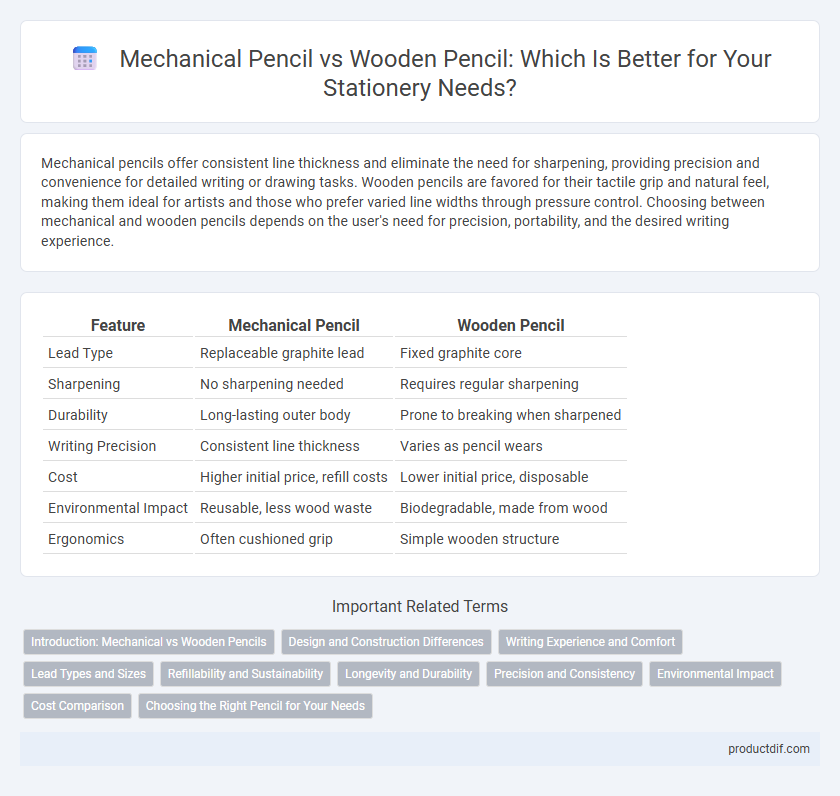Mechanical pencils offer consistent line thickness and eliminate the need for sharpening, providing precision and convenience for detailed writing or drawing tasks. Wooden pencils are favored for their tactile grip and natural feel, making them ideal for artists and those who prefer varied line widths through pressure control. Choosing between mechanical and wooden pencils depends on the user's need for precision, portability, and the desired writing experience.
Table of Comparison
| Feature | Mechanical Pencil | Wooden Pencil |
|---|---|---|
| Lead Type | Replaceable graphite lead | Fixed graphite core |
| Sharpening | No sharpening needed | Requires regular sharpening |
| Durability | Long-lasting outer body | Prone to breaking when sharpened |
| Writing Precision | Consistent line thickness | Varies as pencil wears |
| Cost | Higher initial price, refill costs | Lower initial price, disposable |
| Environmental Impact | Reusable, less wood waste | Biodegradable, made from wood |
| Ergonomics | Often cushioned grip | Simple wooden structure |
Introduction: Mechanical vs Wooden Pencils
Mechanical pencils offer consistent line width and eliminate sharpening, providing precision for detailed writing and drawing tasks, while wooden pencils deliver a natural tactile experience and versatile shading through variable pressure and sharpening. Mechanical pencils feature replaceable leads and ergonomic designs that enhance control and reduce hand fatigue. Wooden pencils, crafted from sustainable wood, are biodegradable and favored for their traditional simplicity and environmental benefits.
Design and Construction Differences
Mechanical pencils feature a durable plastic or metal barrel housing a thin, refillable graphite lead, offering consistent line width and extended use without sharpening. Wooden pencils consist of a solid wooden casing surrounding a graphite core that gradually wears down and requires frequent sharpening to maintain a fine point. The mechanical pencil's internal clutch mechanism contrasts with the simple solid construction of wooden pencils, influencing weight, grip, and precision in writing or drawing tasks.
Writing Experience and Comfort
Mechanical pencils offer consistent line thickness and require less frequent sharpening, enhancing writing precision and comfort for prolonged use. Wooden pencils provide a natural grip and smoother shading transitions, preferred by artists and those who write with varied pressure. Ergonomic designs in mechanical pencils reduce hand fatigue, while wooden pencils offer tactile feedback that some users find more satisfying.
Lead Types and Sizes
Mechanical pencils typically use standardized lead sizes such as 0.3mm, 0.5mm, 0.7mm, and 0.9mm, offering consistent line thickness and precise control. Wooden pencils come in various lead grades ranging from 9B (softest and darkest) to 9H (hardest and lightest), providing a broad spectrum of shading options but with variable line thickness. Mechanical pencils often use HB or B leads for general writing, while wooden pencils are favored for artistic purposes due to their diverse lead hardness and thickness.
Refillability and Sustainability
Mechanical pencils offer superior refillability, allowing users to replace lead multiple times, which reduces waste compared to wooden pencils that require frequent sharpening and eventual disposal. Wooden pencils, typically made from non-renewable timber, contribute to deforestation, while mechanical pencils often use durable plastic or metal bodies designed for long-term use. Choosing mechanical pencils supports sustainability by minimizing resource consumption and waste generation over time.
Longevity and Durability
Mechanical pencils offer superior longevity compared to wooden pencils due to their refillable leads, reducing the need for frequent replacements. Their durable plastic or metal bodies withstand wear and tear better than wooden casings, which can crack or splinter. While wooden pencils require regular sharpening that shortens their lifespan, mechanical pencils maintain consistent functionality over extended periods.
Precision and Consistency
Mechanical pencils offer superior precision due to their fine, uniform lead that maintains a consistent tip size, ideal for detailed drawing and technical writing. Wooden pencils, while versatile, require regular sharpening, which can lead to variable line thickness and less consistent precision. For tasks demanding exactness and steady performance, mechanical pencils provide more reliable consistency over time.
Environmental Impact
Mechanical pencils generate less waste over time by using refillable leads, reducing the need for frequent replacements typical of wooden pencils, which are single-use. Wooden pencils contribute to deforestation due to the large amounts of timber required for mass production, while mechanical pencils' plastic and metal components may pose recycling challenges if not properly disposed of. Choosing a mechanical pencil with biodegradable or recyclable materials and sustainably sourced wooden pencils can further lessen environmental impact in stationery use.
Cost Comparison
Mechanical pencils generally have a higher upfront cost, averaging $5 to $15 per unit, but their refillable leads reduce long-term expenses compared to wooden pencils, which cost about $0.10 to $0.50 each but require frequent replacement. Over time, mechanical pencils prove more economical for heavy users due to lead refills costing approximately $1 to $3 per pack of 12, whereas continuous purchases of wooden pencils accumulate higher costs. The cost-effectiveness of mechanical pencils becomes more apparent in academic or professional settings with frequent writing needs.
Choosing the Right Pencil for Your Needs
Mechanical pencils offer consistent line thickness and eliminate the need for sharpening, making them ideal for precision tasks and frequent writing. Wooden pencils provide a natural grip and smoother shading variations, preferred by artists and those who enjoy tactile feedback. Selecting the right pencil depends on your specific use, whether detailed drafting or expressive sketching.
Mechanical pencil vs Wooden pencil Infographic

 productdif.com
productdif.com